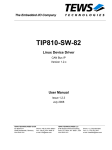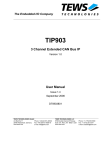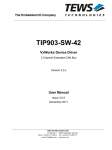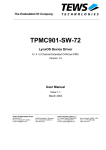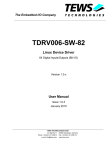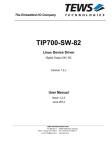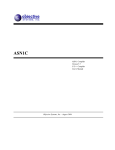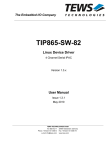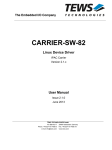Download User Manual - TEWS TECHNOLOGIES
Transcript
The Embedded I/O Company TIP903-SW-82 Linux Device Driver 3 Channel Extended CAN Bus IP Version 1.2.x User Manual Issue 1.2.3 November 2010 TEWS TECHNOLOGIES GmbH Am Bahnhof 7 25469 Halstenbek, Germany Phone: +49 (0) 4101 4058 0 Fax: +49 (0) 4101 4058 19 e-mail: [email protected] www.tews.com TIP903-SW-82 This document contains information, which is proprietary to TEWS TECHNOLOGIES GmbH. Any reproduction without written permission is forbidden. Linux Device Driver 3 Channel Extended CAN Bus IP TEWS TECHNOLOGIES GmbH has made any effort to ensure that this manual is accurate and complete. However TEWS TECHNOLOGIES GmbH reserves the right to change the product described in this document at any time without notice. TEWS TECHNOLOGIES GmbH is not liable for any damage arising out of the application or use of the device described herein. 2004-2010 by TEWS TECHNOLOGIES GmbH Issue Description Date 1.0 First Issue October 2, 2002 1.1 Support for DEVFS and SMP February 25, 2004 1.2.0 Introduction and installation description modified April 05, 2006 1.2.1 UDEV description added December 11, 2007 1.2.2 Carrier Driver description added July 7, 2008 1.2.3 General revision, Address TEWS LLC removed Avoiding undefined symbols warning note November 25, 2010 TIP903-SW-82 - Linux Device Driver Page 2 of 40 Table of Contents 1 INTRODUCTION......................................................................................................... 4 1.1 Device Driver ...................................................................................................................................4 1.2 IPAC Carrier Driver .........................................................................................................................5 2 INSTALLATION.......................................................................................................... 6 2.1 2.2 2.3 2.4 2.5 2.6 3 DEVICE INPUT/OUTPUT FUNCTIONS ................................................................... 10 3.1 3.2 3.3 3.4 3.5 4 Build and install the device driver.................................................................................................7 Uninstall the device driver .............................................................................................................7 Install device driver into the running kernel ................................................................................8 Remove device driver from the running kernel ...........................................................................8 Change Major Device Number .......................................................................................................9 Receive Queue Configuration........................................................................................................9 open() .............................................................................................................................................10 close().............................................................................................................................................12 read() ..............................................................................................................................................13 write() .............................................................................................................................................16 ioctl() ..............................................................................................................................................19 3.5.1 T903_IOCSBITTIMING .......................................................................................................21 3.5.2 T903_IOCSSETFILTER......................................................................................................23 3.5.3 T903_IOCGGETFILTER .....................................................................................................25 3.5.4 T903_IOCBUSON ...............................................................................................................27 3.5.5 T903_IOCBUSOFF .............................................................................................................28 3.5.6 T903_IOCFLUSH ................................................................................................................29 3.5.7 T903_IOCGCANSTATUS ...................................................................................................30 3.5.8 T903_IOCSDEFRXBUF ......................................................................................................31 3.5.9 T903_IOCSDEFRMTBUF ...................................................................................................33 3.5.10 T903_IOCSUPDATEBUF ...................................................................................................35 3.5.11 T903_IOCTRELEASEBUF..................................................................................................37 DEBUGGING ............................................................................................................ 39 TIP903-SW-82 - Linux Device Driver Page 3 of 40 1 Introduction 1.1 Device Driver The TIP903-SW-82 Linux device driver allows the operation of TIP903 IPAC modules on Linux operating systems. Because the TIP903 device driver is stacked on the TEWS TECHNOLOGIES IPAC carrier driver, it’s necessary to install also the appropriate IPAC carrier driver. Please refer to the IPAC carrier driver user manual for further information. The TIP903 device driver includes the following features: Transmission and receive of Standard and extended Identifiers Up to 15 receive message queues with user defined size Variable allocation of receive message objects to receive queues Separate task queues for each receive queue and transmission buffer message object Standard bit rates from 20 kbit up to 1.0 Mbit and user defined bit rates Message acceptance filtering Definition of receive and remote buffer message objects Transmission and receive of Standard and extended Identifiers Designed as Linux kernel module with dynamically loading (modprobe). Supports shared IRQ’s. Creates devices with dynamically allocated or fixed major device numbers. The TIP903-SW-82 supports the modules listed below: TIP903-10 3 channel extended CAN bus IndustryPack (IndustryPack®) To get more information about the features and use of the supported devices it is recommended to read the manuals listed below. TIP903 User manual TIP903 Engineering Manual Architectural Overview of the Intel 82527 CAN controller (part of TIP903 Engineering Manual) CARRIER-SW-82 IPAC Carrier User Manual TIP903-SW-82 - Linux Device Driver Page 4 of 40 1.2 IPAC Carrier Driver IndustryPack (IPAC) carrier boards have different implementations of the system to IndustryPack bus bridge logic, different implementations of interrupt and error handling and so on. Also the different byte ordering (big-endian versus little-endian) of CPU boards will cause problems on accessing the IndustryPack I/O and memory spaces. To simplify the implementation of IPAC device drivers which work with any supported carrier board, TEWS TECHNOLOGIES has designed a so called Carrier Driver that hides all differences of different carrier boards under a well defined interface. The TEWS TECHNOLOGIES IPAC Carrier Driver CARRIER-SW-82 is part of this TIP903-SW-82 distribution. It is located in directory CARRIER-SW-82 on the corresponding distribution media. This IPAC Device Driver requires a properly installed IPAC Carrier Driver. Due to the design of the Carrier Driver, it is sufficient to install the IPAC Carrier Driver once, even if multiple IPAC Device Drivers are used. Please refer to the CARRIER-SW-82 User Manual for a detailed description how to install and setup the CARRIER-SW-82 device driver, and for a description of the TEWS TECHNOLOGIES IPAC Carrier Driver concept. TIP903-SW-82 - Linux Device Driver Page 5 of 40 2 Installation The directory TIP903-SW-82 on the distribution media contains the following files: TIP903-SW-82-1.2.3.pdf This manual in PDF format TIP903-SW-82-SRC.tar.gz GZIP compressed archive with driver source code ChangeLog.txt Release history Release.txt Release information The GZIP compressed archive TIP903-SW-82.tar.gz contains the following files and directories: tip903/tip903.c tip903/tip903def.h tip903/tip903.h tip903/I82527.h tip903/makenode tip903/Makefile tip903/example/tip903exa.c tip903/example/Makefile tip903/include/config.h tip903/include/tpmodule.h tip903/include/tpmodule.c Driver source code Driver include file Driver include file for application program Intel 82527 CAN controller definitions Script to create device nodes on the file system Device driver make file Example application Example application make file Kernel independent header file Kernel independent library header file Kernel independent library source code file In order to perform an installation, extract all files of the archive TIP903-SW-82-SRC.tar.gz to the desired target directory. The command ‘tar -xzvf TIP903-SW-82-SRC.tar.gz’ will extract the files into the local directory. Before building a new device driver, the TEWS TECHNOLOGIES IPAC carrier driver must be installed properly, because this driver includes the header file ipac_carrier.h, which is part of the IPAC carrier driver distribution. Please refer to the IPAC carrier driver user manual in the directory path CARRIER-SW-82 on the separate distribution media. TIP903-SW-82 - Linux Device Driver Page 6 of 40 2.1 Build and install the device driver Login as root Change to the target directory Copy file tip903.h to /usr/include/ to allow user application access To create and install the driver in the module directory /lib/modules/<version>/misc enter: # make install For Linux kernel 2.6.x, there may be compiler warnings claiming some undefined ipac_* symbols. These warnings are caused by exported symbols of the IPAC carrier driver, which are unknown during compilation of this TIP driver. These warnings can be ignored or avoided by defining the path where the symbol definitions can be found (works only for kernel versions >2.6.28). To avoid these warnings the symbol KBUILD_EXTRA_SYMBOLS can be added to the make command line and must specify the absolute path where the symbols of the IPAC carrier driver can be found. For example: make install KBUILD_EXTRA_SYMBOLS=/usr/ipac_carrier/class/Module.symvers Also after the first build we have to execute depmod to create a new dependency description for loadable kernel modules. This dependency file is later used by modprobe to automatically load the correct IPAC carrier driver modules. # depmod –aq 2.2 Uninstall the device driver Login as root Change to the target directory To remove the driver from the module directory /lib/modules/<version>/misc enter: # make uninstall Update kernel module dependency description file # depmod –aq TIP903-SW-82 - Linux Device Driver Page 7 of 40 2.3 Install device driver into the running kernel To load the device driver into the running kernel, login as root and execute the following commands: # modprobe tip903drv After the first build or if you are using dynamic major device allocation it’s necessary to create new device nodes on the file system. Please execute the script file makenode to do this. If your kernel has enabled a device file system (devfs or sysfs with udev) then you have to skip running the makenode script. Instead of creating device nodes from the script the driver itself takes creating and destroying of device nodes in its responsibility. # sh makenode On success the device driver will create a minor device for each TIP903 CAN channel found. The first TIP903 channel can be accessed using device node /dev/tip903_0, the second TIP903 channel with device node /dev/tip903_1, the third channel TIP903 with device node /dev/tip903_2 and so on. The allocation of device nodes to physical TIP903 modules depends on the search order of the IPAC carrier driver. Please refer to the IPAC carrier user manual. Loading of the TIP903 device driver will only work if kernel KMOD support is installed, necessary carrier board drivers already installed and the kernel dependency file is up to date. If KMOD support isn’t available you have to build either a new kernel with KMOD installed or you have to install the IPAC carrier kernel modules manually in the correct order (please refer to the IPAC carrier driver user manual). 2.4 Remove device driver from the running kernel To remove the device driver from the running kernel login as root and execute the following command: # modprobe tip903drv –r If your kernel has enabled devfs or sysfs (udev), all /dev/tip903_x nodes will be automatically removed from your file system after this. Be sure that the driver isn’t opened by any application program. If opened you will get the response “tip903drv: Device or resource busy” and the driver will still remain in the system until you close all opened files and execute modprobe –r again. TIP903-SW-82 - Linux Device Driver Page 8 of 40 2.5 Change Major Device Number The TIP903 driver use dynamic allocation of major device numbers by default. If this isn’t suitable for the application it’s possible to define a major number for the driver. If the kernel has enabled devfs the driver will not use the symbol TIP903_MAJOR. To change the major number edit the file tip903drv.c, change the following symbol to appropriate value and enter make install to create a new driver. TIP903_MAJOR Valid numbers are in range between 0 and 255. A value of 0 means dynamic number allocation. Example: #define TIP903_MAJOR 122 2.6 Receive Queue Configuration Received CAN messages will be stored in receive queues. Each receive queue contains a FIFO and a separate task wait queue. The number of receive queues and the depth of the FIFO can be adapted by changing the following symbols in tip903.c. NUM_RX_QUEUES Defines the number of receive queues for each device (default = 3). Valid numbers are in range between 1 and 15. To support multitasking and multiprocessing the driver allows only one thread per queue. So NUM_RX_QUEUES is the same as the maximum amount of concurrent threads during reading. RX_FIFO_SIZE Defines the depth of the message FIFO inside each receive queue (default = 100). Valid numbers are in range between 1 and MAXINT. TIP903-SW-82 - Linux Device Driver Page 9 of 40 3 Device Input/Output functions This chapter describes the interface to the device driver I/O system. 3.1 open() NAME open() - open a file descriptor SYNOPSIS #include <fcntl.h> int open (const char *filename, int flags) DESCRIPTION The open function creates and returns a new file descriptor for the file named by filename. The flags argument controls how the file is to be opened. This is a bit mask; you create the value by the bitwise OR of the appropriate parameters (using the | operator in C). See also the GNU C Library documentation for more information about the open function and open flags. EXAMPLE int fd; fd = open(“/dev/tip903_0”, O_RDWR); if (fd == -1) { /* handle error condition */ } RETURNS The normal return value from open is a non-negative integer file descriptor. In the case of an error, a value of –1 is returned. The global variable errno contains the detailed error code. TIP903-SW-82 - Linux Device Driver Page 10 of 40 ERRORS ENODEV The requested minor device does not exist. This is the only error code returned by the driver, other codes may be returned by the I/O system during open. SEE ALSO GNU C Library description – Low-Level Input/Output TIP903-SW-82 - Linux Device Driver Page 11 of 40 3.2 close() NAME close() – close a file descriptor SYNOPSIS #include <unistd.h> int close (int filedes) DESCRIPTION The close function closes the file descriptor filedes. EXAMPLE int fd; if (close(fd) != 0) { /* handle close error conditions */ } RETURNS The normal return value from close is 0. In the case of an error, a value of –1 is returned. The global variable errno contains the detailed error code. ERRORS ENODEV The requested minor device does not exist. This is the only error code returned by the driver, other codes may be returned by the I/O system during close. For more information about close error codes, see the GNU C Library description – LowLevel Input/Output. SEE ALSO GNU C Library description – Low-Level Input/Output TIP903-SW-82 - Linux Device Driver Page 12 of 40 3.3 read() NAME read() – read from a device SYNOPSIS #include <unistd.h> ssize_t read(int filedes, void *buffer, size_t size) DESCRIPTION The read function reads a CAN message from the specified receive queue. A pointer to the callers message buffer (T903_MSG_BUF) and the size of this structure are passed by the parameters buffer and size to the device. The T903_MSG_BUF structure has the following layout: typedef struct { unsigned long identifier; long timeout; unsigned char rx_queue_num; unsigned char extended; unsigned char status; unsigned char msg_len; unsigned char data[8]; } T903_MSG_BUF, *PT903_MSG_BUF; identifier Receives the message identifier of the read CAN message. timeout Specifies the amount of time (in ticks) the caller is willing to wait for execution of read. A value of 0 means wait indefinitely. rx_queue_num Specifies the receive queue number from which the data will be read. Valid receive queue numbers are in range between 1 and n. In which n depends on the definition of NUM_RX_QUEUES (see also 2.6). extended Receives TRUE for extended CAN messages. TIP903-SW-82 - Linux Device Driver Page 13 of 40 status Receives status information about overrun conditions either in the CAN controller or intermediate software FIFO’s. T903_SUCCESS No messages lost T903_FIFO_OVERRUN One or more messages was overwritten in the receive queue FIFO. This problem occurs if the FIFO is too small for the application read interval. T903_MSGOBJ_OVERRUN One or more messages were overwritten in the CAN controller message object because the interrupt latency is too large. Keep in mind Linux isn’t a real-time operating system. Use message object 15 (buffered) to receive this time critical CAN messages, reduce the CAN bit rate or upgrade the system speed. T903_RAW_FIFO_OVERRUN One or more messages was overwritten in the FIFO between the interrupt service routine and postprocessing in the driver (bottom half). msg_len Receives the number of message data bytes (0...8). data This buffer receives up to 8 data bytes. data[0] receives message data 0, data[1] receives message data 1 and so on. EXAMPLE #include <tip903.h> int ssize_t T903_MSG_BUF fd; NumBytes; MsgBuf; MsgBuf.rx_queue_num MsgBuf.timeout = 1; = 200; NumBytes = read(fd, &MsgBuf, sizeof(MsgBuf)); if (NumBytes > 0) { /* process received CAN message */ } TIP903-SW-82 - Linux Device Driver Page 14 of 40 RETURNS On success read returns the size of structure T903_MSG_BUF. In the case of an error, a value of –1 is returned. The global variable errno contains the detailed error code. ERRORS EINVAL Invalid argument. This error code is returned if either the size of the message buffer is too small, or the specified receive queue is out of range. EFAULT Invalid pointer to the message buffer. ECONNREFUSED The controller is in bus off state and no message is available in the specified receive queue. Note, as long as CAN messages are available in the receive queue FIFO, bus off conditions were not reported by a read function. This means you can read all CAN messages out of the receive queue FIFO during bus off state without an error result. EAGAIN Resource temporarily unavailable; the call might work if you try again later. This error occurs only if the device is opened with the flag O_NONBLOCK set. ETIME The allowed time to finish the read request is elapsed. EINTR Interrupted function call; an asynchronous signal occurred and prevented completion of the call. When this happens, you should try the call again. SEE ALSO GNU C Library description – Low-Level Input/Output TIP903-SW-82 - Linux Device Driver Page 15 of 40 3.4 write() NAME write() – write to a device SYNOPSIS #include <unistd.h> ssize_t write(int filedes, void *buffer, size_t size) DESCRIPTION The write function writes a CAN message to the device with descriptor filedes. A pointer to the callers message buffer (T903_MSG_BUF) and the size of this structure are passed by the parameters buffer and size to the device. The write function dynamically allocates a free message object for the transmit operation. The search begins at message object 1 and ends at message object 14. The first found free message object is used. If currently no message object is available the write operation is blocked until any message object becomes free or a timeout occur. If your application performs write operations you should left at least one message object free for transmit, preferably the first message object. The T903_MSG_BUF structure has the following layout: typedef struct { unsigned long identifier; long timeout; unsigned char rx_queue_num; unsigned char extended; unsigned char status; unsigned char msg_len; unsigned char data[8]; } T903_MSG_BUF, *PT903_MSG_BUF; identifier Contains the message identifier of the CAN message to write. timeout Specifies the amount of time (in ticks) the caller is willing to wait for execution of write. A value of 0 means wait indefinitely. rx_queue_num This parameter is unused for this control function. TIP903-SW-82 - Linux Device Driver Page 16 of 40 extended This parameter is TRUE (1) for extended CAN messages. status This parameter is unused for this control function. msg_len Contains the number of message data bytes (0...8). data This buffer contains up to 8 data bytes. Data[0] contains message data 0, data[1] contains message data 1 and so on. EXAMPLE #include <tip903.h> int ssize_t T903_MSG_BUF fd; NumBytes; MsgBuf; MsgBuf.identifier MsgBuf.timeout MsgBuf.extended MsgBuf.msg_len MsgBuf.data[0] MsgBuf.data[1] = = = = = = 1234; 200; TRUE; 2; 0xaa; 0x55; NumBytes = write(fd, &MsgBuf, sizeof(MsgBuf)); if (NumBytes > 0) { /* CAN message successful transmitted */ } RETURNS On success write returns the size of structure T903_MSG_BUF. In the case of an error, a value of –1 is returned. The global variable errno contains the detailed error code. TIP903-SW-82 - Linux Device Driver Page 17 of 40 ERRORS EINVAL Invalid argument. This error code is returned if the size of the message buffer is too small. EFAULT Invalid pointer to the message buffer. ECONNREFUSED The controller is in bus off state and unable to transmit messages. EAGAIN Resource temporarily unavailable; the call might work if you try again later. This error occurs only if the device is opened with the flag O_NONBLOCK set. ETIME The allowed time to finish the write request is elapsed. This occurs if currently no message object is available or if the CAN bus is overloaded and the priority of the message identifier is too low. EINTR Interrupted function call; an asynchronous signal occurred and prevented completion of the call. When this happens, you should try the call again. SEE ALSO GNU C Library description – Low-Level Input/Output TIP903-SW-82 - Linux Device Driver Page 18 of 40 3.5 ioctl() NAME ioctl() – device control functions SYNOPSIS #include <sys/ioctl.h> int ioctl(int filedes, int request [, void *argp]) DESCRIPTION The ioctl function sends a control code directly to a device, specified by filedes, causing the corresponding device to perform the requested operation. The argument request specifies the control code for the operation. The optional argument argp depends on the selected request and is described for each request in detail later in this chapter. The following ioctl codes are defined in tip903.h: Symbol Description T903_IOCSBITTIMING Setup new bit timing T903_IOCSSETFILTER Setup acceptance filter masks T903_IOCGGETFILTER Get the current acceptance filter masks T903_IOCBUSON Enter the bus on state T903_IOCBUSOFF Enter the bus off state T903_IOCFLUSH Flush one or all receive queues T903_IOCGCANSTATUS Returns the CAN controller status T903_IOCSDEFRXBUF Define a receive buffer message object T903_IOCSDEFRMTBUF Define a remote transmit buffer message object T903_IOCSUPDATEBUF Update a remote or receive buffer message object T903_IOCTRELEASEBUF Release an allocated message buffer object See behind for more detailed information on each control code. To use these TIP903 specific control codes the header file tip903.h must be included in the application TIP903-SW-82 - Linux Device Driver Page 19 of 40 RETURNS On success, zero is returned. In the case of an error, a value of –1 is returned. The global variable errno contains the detailed error code. ERRORS EINVAL Invalid argument. This error code is returned if the requested ioctl function is unknown. Please check the argument request. Other function dependant error codes will be described for each ioctl code separately. Note, the TIP903 driver always returns standard Linux error codes. SEE ALSO ioctl man pages TIP903-SW-82 - Linux Device Driver Page 20 of 40 3.5.1 T903_IOCSBITTIMING NAME T903_IOCSBITTIMING - Setup new bit timing DESCRIPTION This ioctl function modifies the bit timing register of the CAN controller to setup a new CAN bus transfer speed. A pointer to the callers parameter buffer (T903_BITTIMING) is passed by the argument argp to the driver. Keep in mind to setup a valid bit timing value before changing into the Bus On state. The T903_BITTIMING structure has the following layout: typedef struct { unsigned short timing_value; unsigned short three_samples; } T903_BITTIMING, *PT903_BITTIMING; timing_value This parameter holds the new values for the bit timing register 0 (bit 0...7) and for the bit timing register 1 (bit 8...15). Possible transfer rates are between 20 kBit per second and 1.0 MBit per second. The include file 'tip903.h' contains predefined transfer rate symbols (T903_20KBIT ... T903_1_0MBIT). For other transfer rates please follow the instructions of the Intel 82527 Architectural Overview, which is also part of the engineering kit TIP903-EK. three_samples If this parameter is TRUE (1) the CAN bus is sampled three times per bit time instead of one. Use one sample point for faster bit rates and three sample points for slower bit rate to make the CAN bus more immune against noise spikes. TIP903-SW-82 - Linux Device Driver Page 21 of 40 EXAMPLE #include <tip903.h> int int T903_BITTIMING fd; result; BitTimingParam; BitTimingParam.timing_value = T903_100KBIT; BitTimingParam.ThreeSamples = FALSE; result = ioctl(fd, T903_IOCSBITTIMING, &BitTimingParam); if (result < 0) { /* handle ioctl error */ } ERRORS EFAULT Invalid pointer to the parameter buffer. Please check the argument argp SEE ALSO tip903.h for predefined bus timing constants TIP903-SW-82 - Linux Device Driver Page 22 of 40 3.5.2 T903_IOCSSETFILTER NAME T903_IOCSSETFILTER - Setup acceptance filter masks DESCRIPTION This ioctl function modifies the acceptance filter masks of the specified CAN controller device. The acceptance masks allow message objects to receive messages with a larger range of message identifiers instead of just a single message identifier. A "0" value means "don't care" or accept a "0" or "1" for that bit position. A "1"-value means that the incoming bit value "must-match" identically to the corresponding bit in the message identifier. A pointer to the callers parameter buffer (T903_ACCEPT_MASKS) is passed by the parameter argp to the driver. The T903_ACCEPT_MASKS structure has the following layout: typedef struct { unsigned long message_15_mask; unsigned long global_mask_extended; unsigned short global_mask_standard; } T903_ACCEPT_MASKS, *PT903_ACCEPT_MASKS; message_15_mask This parameter specifies the value for the Message 15 Mask Register. The Message 15 Mask Register is a local mask for message object 15. This 29 bit identifier mask appears in bit 3...31 of this parameter. The Message 15 Mask is "ANDed" with the Global Mask. This means that any bit defined as "don't care" in the Global Mask will automatically be a "don't care" bit for message 15. (See also Intel 82527 Architectural Overview). global_mask_extended This parameter specifies the value for the Global Mask-extended Register. The Global Maskextended Register applies only to messages using the extended CAN identifier. This 29 bit identifier mask appears in bit 3...31 of this parameter. global_mask_standard This parameter specifies the value for the Global Mask-Standard Register. The Global MaskStandard Register applies only to messages using the standard CAN identifier. The 11 bit identifier mask appears in bit 5...15 of this parameter. The TIP903 device driver copies the parameter directly into the corresponding registers of the CAN controller, without shifting any bit positions. For more information see the Intel 82527 Architectural Overview. TIP903-SW-82 - Linux Device Driver Page 23 of 40 EXAMPLE #include <tip903.h> int int T903_ACCEPT_MASKS fd; result; AcceptMasksParam; /* Standard identifier bits 0..3 don't care */ AcceptMasksParam.global_mask_standard = 0xfe00; /* extended identifier bits 0..3 don't care */ AcceptMasksParam.global_mask_extended = 0xffffff80; /* Message object 15 identifier bits 0..7 don't care */ AcceptMasksParam.message_15_mask = 0xfffff800; result = ioctl(fd, T903_IOCSSETFILTER, &AcceptMasksParam); if (result < 0) { /* handle ioctl error */ } ERRORS EFAULT TIP903-SW-82 - Linux Device Driver Invalid pointer to the parameter buffer. Please check the argument argp. Page 24 of 40 3.5.3 T903_IOCGGETFILTER NAME T903_IOCGGETFILTER - Get the current acceptance filter masks DESCRIPTION This ioctl function returns the current acceptance filter masks of the specified CAN Controller. A pointer to the callers parameter buffer (T903_ACCEPT_MASKS) is passed by the parameter argp to the driver. The T903_ACCEPT_MASKS structure has the following layout: typedef struct { unsigned long message_15_mask; unsigned long global_mask_extended; unsigned short global_mask_standard; } T903_ACCEPT_MASKS, *PT903_ACCEPT_MASKS; message_15_mask This parameter receives the value for the Message 15 Mask Register. The Message 15 Mask Register is a local mask for message object 15. This 29 bit identifier mask appears in bit 3...31 of this parameter. global_mask_extended This parameter receives the value for the Global Mask-extended Register. The Global Maskextended Register applies only to messages using the extended CAN identifier. This 29 bit identifier mask appears in bit 3...31 of this parameter. global_mask_standard This parameter receives the value for the Global Mask-Standard Register. The Global MaskStandard Register applies only to messages using the standard CAN identifier. The 11 bit identifier mask appears in bit 5...15 of this parameter. The TIP903 device driver copies the masks directly from the corresponding registers of the CAN controller into the parameter buffer, without shifting any bit positions. For more information see the Intel 82527 Architectural Overview. TIP903-SW-82 - Linux Device Driver Page 25 of 40 EXAMPLE #include <tip903.h> int int T903_ACCEPT_MASKS fd; result; AcceptMasksParam; result = ioctl(fd, T903_IOCGGETFILTER, &AcceptMasksParam); if (result < 0) { /* handle ioctl error */ } ERRORS EFAULT TIP903-SW-82 - Linux Device Driver Invalid pointer to the parameter buffer. Please check the argument argp. Page 26 of 40 3.5.4 T903_IOCBUSON NAME T903_IOCBUSON - Enter the bus on state DESCRIPTION This ioctl function sets the specified CAN controller into the Bus On state. After an abnormal rate of occurrences of errors on the CAN bus or after driver startup, the CAN controller enters the Bus Off state. This control function resets the init bit in the control register. The CAN controller begins the busoff recovery sequence and resets transmit and receive error counters. If the CAN controller counts 128 packets of 11 consecutive recessive bits on the CAN bus, the Bus Off state is exited. The optional argument can be omitted for this ioctl function. Before the driver is able to communicate over the CAN bus after driver startup, this control function must be executed. EXAMPLE #include <tip903.h> int int fd; result; result = ioctl(fd, T903_IOCBUSON); if (result < 0) { /* handle ioctl error */ } ERRORS This ioctl function returns no function specific error codes. TIP903-SW-82 - Linux Device Driver Page 27 of 40 3.5.5 T903_IOCBUSOFF NAME T903_IOCBUSOFF - Enter the bus off state DESCRIPTION This ioctl function sets the specified CAN controller into the Bus-Off state. After a successful execution of this control function the CAN controller is completely removed from the CAN bus and cannot communicate until the control function T903_IOCBUSON is executed. Note: It’s not possible to set the device bus off during a write operation of another concurrent process. The optional argument can be omitted for this ioctl function. Execute this control function before the last close to the CAN controller channel. EXAMPLE #include <tip903.h> int int fd; result; result = ioctl(fd, T903_IOCBUSOFF); if (result < 0) { /* handle ioctl error */ } ERRORS EBUSY TIP903-SW-82 - Linux Device Driver Device busy. Another concurrent process is writing to the device at the moment. Try it again later. Page 28 of 40 3.5.6 T903_IOCFLUSH NAME T903_IOCFLUSH - Flush one or all receive queues DESCRIPTION This ioctl function flushes the message FIFO of the specified receive queue(s). The optional argument argp passes the receive queue number to the device driver on which the FIFO’s to be flushed. If this parameter is 0 the FIFO’s of all receive queues of the device will be flushed, otherwise only the FIFO of the specified receive queue will be flushed. EXAMPLE #include <tip903.h> int int fd; result; /* flush all receive queues */ result = ioctl(fd, T903_IOCFLUSH, (int)0); if (result < 0) { /* handle ioctl error */ } ERRORS EINVAL TIP903-SW-82 - Linux Device Driver Invalid argument. This error code is returned if the specified receive queue is out of range. Page 29 of 40 3.5.7 T903_IOCGCANSTATUS NAME T903_IOCGCANSTATUS - Returns the CAN controller status DESCRIPTION This ioctl function returns the actual contents of the CAN controller status register for diagnostic purposes. A pointer to the callers status buffer (T903_STATUS) is passed by the parameter argp to the driver. The T903_STATUS structure has the following layout: typedef struct { unsigned char control_reg; unsigned char status_reg; } T903_STATUS, PT903_STATUS; control_reg This parameter receives the content of the controllers control register. status_reg This parameter receives the content of the controllers status register. EXAMPLE #include <tip903.h> int T903_STATUS fd, result; CanStatus; result = ioctl(fd, T903_IOCGCANSTATUS, &CanStatus); if (result < 0) { /* handle ioctl error */ } ERRORS EFAULT TIP903-SW-82 - Linux Device Driver Invalid pointer to the unsigned char variable which receives the contents of the CAN status register. Please check the argument argp. Page 30 of 40 3.5.8 T903_IOCSDEFRXBUF NAME T903_IOCSDEFRXBUF - Define a receive buffer message object DESCRIPTION This ioctl function defines a CAN message object to receive a single message identifier or a range of message identifiers (see also Acceptance Mask). All CAN messages received by this message object are directed to the associated receive queue and can be read with the standard read function (see also 3.3). Before the driver can receive CAN messages it’s necessary to define at least one receive message object. If only one receive message object is defined at all preferably message object 15 should be used because this message object is buffered. A pointer to the caller’s message description (T903_BUF_DESC) is passed by the argument argp to the driver. The T903_BUF_DESC structure has the following layout: typedef struct { unsigned long identifier; unsigned char msg_obj_num; unsigned char rx_queue_num; unsigned char extended; unsigned char msg_len; unsigned char data[8]; } T903_BUF_DESC, *PT903_BUF_DESC; identifier This parameter specifies the message identifier for the message object to be defined. msg_obj_num Specifies the number of the message object to be defined. Valid object numbers are in range between 1 and 15. rx_queue_num Specifies the associated receive queue for this message object. All CAN messages received by this object are directed to this receive queue. The receive queue number is one based; valid numbers are in range between 1 and n. In which n depends on the definition of NUM_RX_QUEUES (see also 2.6). extended Set to TRUE for extended CAN messages. TIP903-SW-82 - Linux Device Driver Page 31 of 40 msg_len This parameter is unused for this control function. data This parameter is unused for this control function. It’s possible to assign more than one receive message object to one receive queue. EXAMPLE #include <tip903.h> int int T903_BUF_DESC fd; result; BufDesc; BufDesc.msg_obj_num BufDesc.rx_queue_num BufDesc.identifier = BufDesc.extended = = 15; = 1; 1234; TRUE; /* Define message object 15 to receive the extended /* message identifier 1234 and store received messages /* in receive queue 1 */ */ */ result = ioctl(fd, T903_IOCSDEFRXBUF, &BufDesc); if (result < 0) { /* handle ioctl error */ } ERRORS EFAULT Invalid pointer to the parameter buffer. Please check the argument argp. EINVAL Invalid argument. This error code is returned if either the message object number, or the specified receive queue is out of range. EADDRINUSE The requested message object is already occupied. TIP903-SW-82 - Linux Device Driver Page 32 of 40 3.5.9 T903_IOCSDEFRMTBUF NAME T903_IOCSDEFRMTBUF - Define a remote transmit buffer message object DESCRIPTION This ioctl function defines a remote transmission CAN message buffer object. A remote transmission object is similar to normal transmission object with exception that the CAN message is transmitted only after receiving of a remote frame with the same identifier. This type of message object can be used to make process data available for other nodes which can be polled around the CAN bus without any action of the provider node. The message data remain available for other CAN nodes until this message object is updated with the control function T903_IOCSUPDATEBUF or cancelled with T903_IOCTRELEASEBUF. A pointer to the caller’s message description (T903_BUF_DESC) is passed by the argument argp to the driver. The T903_BUF_DESC structure has the following layout: typedef struct { unsigned long identifier; unsigned char msg_obj_num; unsigned char rx_queue_num; unsigned char extended; unsigned char msg_len; unsigned char data[8]; } T903_BUF_DESC, *PT903_BUF_DESC; identifier This parameter specifies the message identifier for the message object to be defined. msg_obj_num Specifies the number of the message object to be defined. Valid object numbers are in range between 1 and 14. Keep in mind that message object 15 is only available for receive message objects. rx_queue_num Unused for remote transmission message objects. Set to 0. extended Set to TRUE for extended CAN messages. TIP903-SW-82 - Linux Device Driver Page 33 of 40 msg_len Contains the number of message data bytes (0...8). data This buffer contains up to 8 data bytes. data[0] contains message data 0, data[1] contains message data 1 and so on. EXAMPLE #include <tip903.h> int int T903_BUF_DESC fd; result; BufDesc; BufDesc.msg_obj_num BufDesc.identifier BufDesc.extended BufDesc.msg_len BufDesc.data[0] = = = = = 10; 777; TRUE; 1; 123; /* Define message object 10 to transmit the extended */ /* message identifier 777 after receiving of a remote */ /* frame with the same identifier */ result = ioctl(fd, T903_IOCSDEFRMTBUF, &BufDesc); if (result < 0) { /* handle ioctl error */ } ERRORS EFAULT Invalid pointer to the parameter buffer. Please check the argument argp. EINVAL Invalid argument. This error code is returned if the message object number is out of range. EADDRINUSE The requested message object is already occupied. EMSGSIZE Invalid message size. msg_len must be in range between 0 and 8. TIP903-SW-82 - Linux Device Driver Page 34 of 40 3.5.10 T903_IOCSUPDATEBUF NAME T903_IOCSUPDATEBUF - Update a remote or receive buffer message object DESCRIPTION This ioctl function updates a previous defined receive or remote transmission message buffer object. To update a receive message object a remote frame is transmitted over the CAN bus to request new data from a corresponding remote transmission message object on other nodes. To update a remote transmission object only the message data and message length of the specified message object is changed. No transmission is initiated by this control function. A pointer to the caller’s message description (T903_BUF_DESC) is passed by the argument argp to the driver. The T903_BUF_DESC structure has the following layout: typedef struct { unsigned long identifier; unsigned char msg_obj_num; unsigned char rx_queue_num; unsigned char extended; unsigned char msg_len; unsigned char data[8]; } T903_BUF_DESC, *PT903_BUF_DESC; identifier This parameter is unused for this control function. msg_obj_num Specifies the number of the message object to be updated. Valid object numbers are in range between 1 and 14. Keep in mind that message object 15 is available only for receive message objects. rx_queue_num This parameter is unused for this control function. extended Set to TRUE for extended CAN messages. msg_len Contains the number of message data bytes (0...8). This parameter is used only for remote transmission object updates. TIP903-SW-82 - Linux Device Driver Page 35 of 40 data This buffer contains up to 8 data bytes. data[0] contains message data 0, data[1] contains message data 1 and so on. This parameter is used only for remote transmission object updates. EXAMPLE #include <tip903.h> int int T903_BUF_DESC fd; result; BufDesc; /* Update a receive message object */ BufDesc.msg_obj_num = 14; result = ioctl(fd, T903_IOCSUPDATEBUF, &BufDesc); if (result < 0) { /* handle ioctl error */ } /* Update a remote message object */ BufDesc.msg_obj_num = 10; BufDesc.msg_len = 1; BufDesc.data[0] = 124; result = ioctl(fd, T903_IOCSUPDATEBUF, &BufDesc); if (result < 0) { /* handle ioctl error */ } ERRORS EFAULT Invalid pointer to the parameter buffer. Please check the argument argp. EINVAL Invalid argument. This error code is returned if either the message object number is out of range or the requested message object is not defined. EMSGSIZE Invalid message size. msg_len must be in range between 0 and 8. TIP903-SW-82 - Linux Device Driver Page 36 of 40 3.5.11 T903_IOCTRELEASEBUF NAME T903_IOCTRELEASEBUF - Release an allocated message buffer object DESCRIPTION This TIP903 control function releases a previous defined CAN message object. Any CAN bus transactions of the specified message object become disabled. After releasing the message object can be defined again with T903_IOCSDEFRXBUF and T903_IOCSDEFRMTBUF control functions. A pointer to the caller’s message description (T903_BUF_DESC) is passed by the argument argp to the driver. The T903_BUF_DESC structure has the following layout: typedef struct { unsigned long identifier; unsigned char msg_obj_num; unsigned char rx_queue_num; unsigned char extended; unsigned char msg_len; unsigned char data[8]; } T903_BUF_DESC, *PT903_BUF_DESC; msg_obj_num Specifies the number of the message object to be released. Valid object numbers are in range between 1 and 15. All other parameters are not used and could be left blank. TIP903-SW-82 - Linux Device Driver Page 37 of 40 EXAMPLE #include <tip903.h> int int T903_BUF_DESC fd; result; BufDesc; BufDesc.msg_obj_num = 14; result = ioctl(fd, T903_IOCTRELEASEBUF, &BufDesc); if (result < 0) { /* handle ioctl error */ } ERRORS EFAULT Invalid pointer to the parameter buffer. Please check the argument argp. EINVAL Invalid argument. This error code is returned if the message object number is out of range. EBADMSG The requested message object is not defined. EBUSY The message object is currently busy transmitting data. TIP903-SW-82 - Linux Device Driver Page 38 of 40 4 Debugging For debugging output see tip903drv.c. You will find the two following symbols: #undef TIP903_DEBUG_INTR #undef TIP903_DEBUG_VIEW To enable a debug output replace “undef” with “define”. The TIP903_DEBUG_INTR symbol controls debugging output from the ISR. TIP903 TIP903 : : interrupt entry IACK[0] vector = 0005 The TIP903_DEBUG_VIEW symbol controls debugging output from the remaining part of the driver. TIP903 - 3 Channel extended CAN Bus IP - version 1.2.3 (2010-11-25) TIP903 : Probe new TIP903 mounted on <TEWS TECHNOLOGIES - (Compact)PCI IPAC Carrier> at slot A TIP903 : IP MEM Memory Space 00000000 : 01 00 61 61 01 00 FF FF FF FF FF F8 00 00 00 00 00000010 : 95 55 74 A0 00 20 00 00 00 00 00 00 00 00 00 00 00000020 : 56 55 02 00 24 00 00 80 40 00 00 00 00 00 40 00 00000030 : 56 55 00 05 04 00 00 00 00 00 02 00 00 00 00 00 00000040 : 55 55 00 34 95 40 00 00 00 00 00 00 00 00 00 00 00000050 : 56 55 00 00 00 00 08 00 80 00 00 82 00 00 00 00 00000060 : 55 55 00 10 00 00 40 00 08 00 00 02 00 00 00 FF 00000070 : 95 59 02 00 02 00 00 00 40 00 20 00 00 00 00 FF 00000080 : 55 55 12 00 02 10 00 00 40 00 00 00 00 42 40 FF 00000090 : 55 55 00 80 20 50 00 00 00 00 00 00 20 00 80 00 000000A0 : 55 55 08 08 00 00 08 04 00 00 00 00 00 00 00 00 000000B0 : 55 55 32 01 04 00 00 00 00 00 00 00 90 00 00 00 000000C0 : 55 65 61 34 10 40 08 00 00 00 00 04 80 00 00 FF 000000D0 : 55 55 A8 62 20 00 00 00 08 00 00 00 00 01 00 00 000000E0 : 55 69 00 34 00 40 04 00 00 00 00 00 40 00 00 00 000000F0 : 95 55 1D A4 07 20 00 00 00 04 10 00 00 00 00 FF TIP903 : IP MEM Memory Space 00000100 : 01 00 61 61 01 00 FF FF FF FF FF F8 00 00 00 00 ... 000001F0 : 95 55 40 53 D1 18 40 00 00 00 00 00 00 00 00 FF TIP903 : IP MEM Memory Space 00000200 : 01 00 61 61 01 00 FF FF FF FF FF F8 00 00 00 00 ... 000002F0 : 95 55 8E 96 AC 48 00 00 00 20 20 00 00 80 10 FF TIP903-SW-82 - Linux Device Driver Page 39 of 40 If you have trouble with the driver please enable the debug output and send us a copy of the results. The kernel context output is generated with “printk” and is appended to /var/log/messages or wherever it’s piped in your system. For debugging please run # tail –f /var/log/messages at first and then install the driver. TIP903-SW-82 - Linux Device Driver Page 40 of 40









































